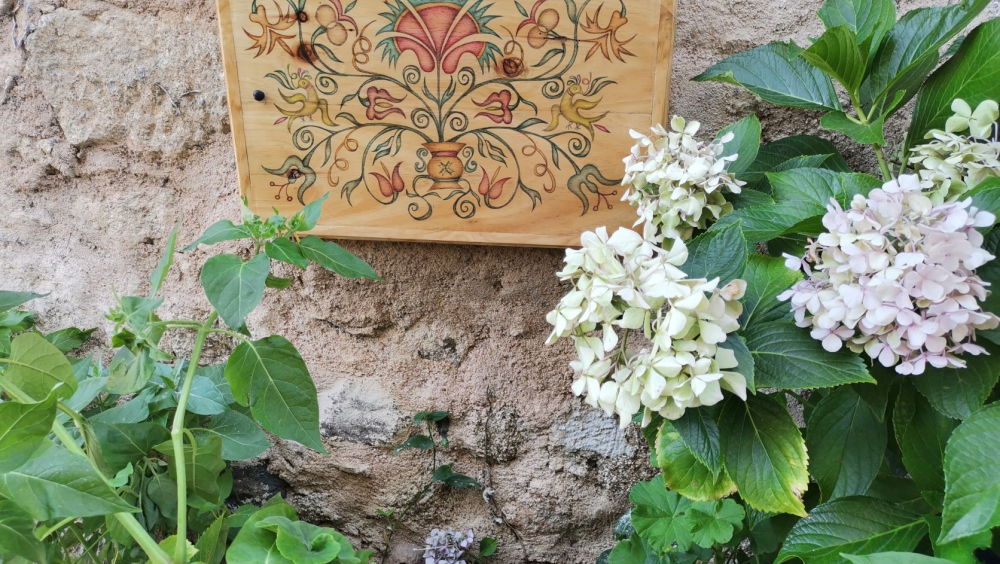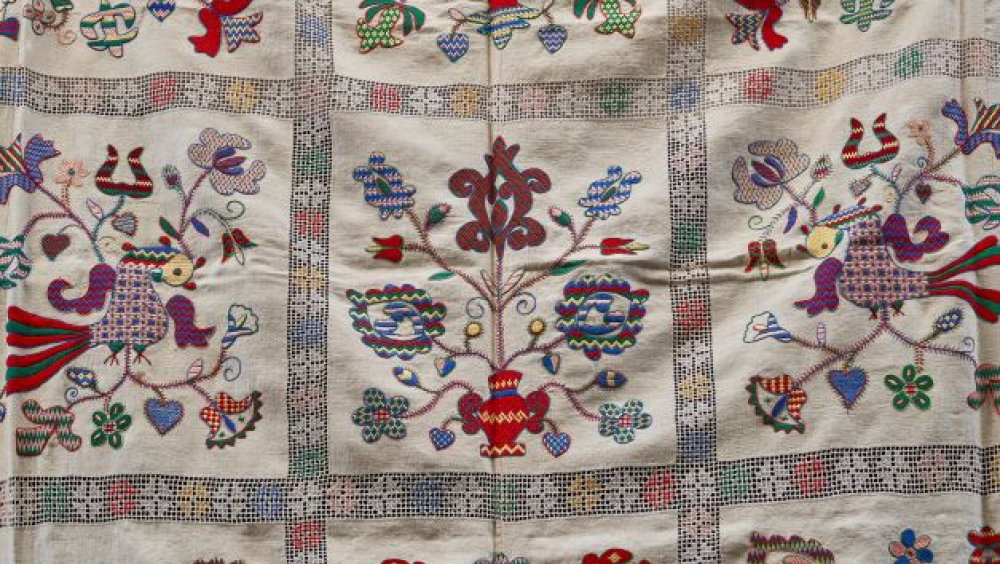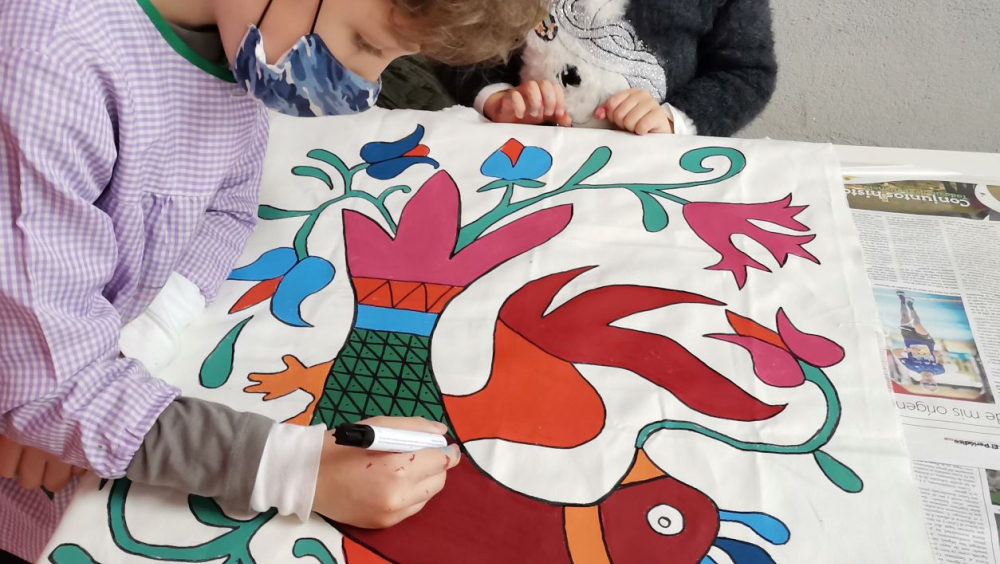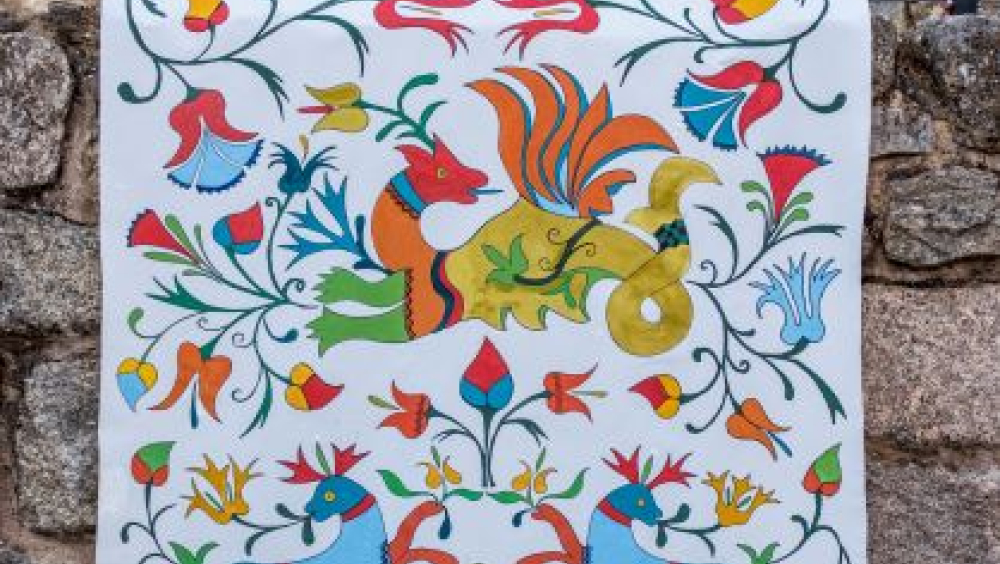Reclaiming a Sense of Belonging, Honouring Cultural Diversity
After several creativity workshops developed by the Red Arrayan Association with groups of women in different towns of the Sierra de Francia in Salamanca, a peripheral territory of the EU, a collective impulse is generated to know and investigate one of the most unique cultural manifestations of this territory: "El Bordado Popular Serrano".
On 28 February 2018, thanks to a process of public-private collaboration between Red Arrayán and the Mogarraz Town Council, the "Plan Entre2" project for the Recognition, Safeguarding and Innovation of the Intangible Cultural Heritage of the Popular Embroidery of the Sierra de Francia arose, generating an important impulse for cultural immersion and mediation throughout the territory and beyond.
The project is articulated in two fundamental axes:
SALVAGUARDA, based on the continuity of a heritage legacy of intercultural character, integrating aesthetics from Northern Europe and the Mediterranean arc, which converge in the Middle Ages in this territory by the trade route and Mozarabic path of the Via de la Plata.
INNOVATION, which researches, explores and generates, through the "Eco-cultural Design and Innovation Laboratory", new meanings and ways of plastic, artistic and educational application, with the guiding thread of the iconographic universe of this immaterial legacy.
The project has promoted the recognition and value of the collective of women artisans in the region, as true bearers of this living cultural legacy of an immaterial nature, generating an important work of research, dissemination, cultural immersion and institutional mediation that has meant its declaration in 2022 as BIC (Bien de Interés Cultural) by the regional government of the Junta de Castilla y León.
This work developed by Red Arrayán has also been recognised in 2022 by UNESCO, being admitted as a collaborating NGO of the Intergovernmental Committee for the Safeguarding of the Intangible Cultural Heritage in the World.
From the organisation Red Arrayán we consider the right of people to know and identify themselves with Cultural Heritage and associated cultural goods, living and sharing a cultural environment that is valued, protected and open to continuous evolution and transformation that generates personal and social wealth, as an essential pillar of human and peoples' development.
From the contact with creativity and the recognition of the personal values generated in the groups of women participating in the CREARTE workshops of Red Arrayán, a group empowerment is spontaneously produced that points to the recognition of one of the most significant and identifying manifestations of the territory where they are the real protagonists: the "Serrano Popular Embroidery". A craft that had not been recognised in all its breadth and intercultural significance, since in the context of a very masculinised society it was always considered a mere entertainment activity for women.
It is from there that Concha Hernández, mayoress of Mogarraz Town Council, proposed to Jose Angel Poveda, a technician of Red Arrayán, the creation of a project to recognise and give value to this activity and the women who carry this centuries-old knowledge passed down from generation to generation in the villages of the Sierra de Francia region of Salamanca.
On 28 February 2018, a public-private cooperation agreement was signed between the two entities approving the EnTre2 Plan, so named for several meanings:
As a link between two pieces of fabric "entredós", but also as a cooperation between two public and private entities led by a female and a male figure and as a link between a traditional manifestation and the innovation it could mean as a creative, aesthetic, educational and cultural immersion element for different population groups and for tourists and visitors.
The first recognition of this initiative comes with the award of the "First Prize Fuentes Claras 2018" of the Junta de Castilla y León for innovation in small municipalities in the region.
From there, and after various contacts with the regional and national government, the contract was awarded for the Documentary Study of Serrano Embroidery, carried out under the direction of Carmen Espinel Olanda due to her knowledge as a historian and textile craftswoman, being the basis of the process of initiation and subsequent declaration in 2022 as an Asset of Cultural Interest by the Junta de Castilla y León.
During these years, with the support of the Ministry of Culture and the Ministry of Culture of the Junta de Castilla y León, different initiatives of dissemination, promotion and cultural immersion have been developed inside and outside the territory, which have largely favoured this institutional recognition, generating a process of cultural mediation with town councils and local entities of the province of Salamanca, which have been joined by other public and private entities such as the University, the Provincial Council and the City Council of Salamanca, as well as the support of the Hispania Nostra Association and the Local Action Group, among others.
The project has two main axes:
The SALVAGUARDA, based on the continuity of a heritage legacy of intercultural character, integrating aesthetics of Northern Europe and the Mediterranean arc, which converge since the Middle Ages in this territory by the trade route and Mozarabic path of the Via de la Plata, generating a cultural syncretism of great value that is being recognised by different peoples and cultures.
INNOVATION, which researches, explores and generates, through the "Eco-cultural Design and Innovation Laboratory", new meanings and fields of plastic, artistic and educational application, with the common thread of the iconographic universe of this immaterial legacy.
The project has promoted the recognition and value of the collective of women artisans in the region, as true bearers of this living cultural legacy of an immaterial nature, generating an important work of social and territorial integration that is generating employment and wealth for different sectors such as crafts and rural tourism, which offers visits and related activities.
In 2020 and 2021, several experiences of cultural immersion, of a manual and artisanal nature were carried out with different population groups, maintaining hygiene and safety measures that served to strengthen the feeling of individual and group resilience, reinforcing identity in the situation of the pandemic crisis.
Among them, an innovative heritage visibility experience has been carried out with different population groups called "Route of the Embroidered Meters of San Esteban de la Sierra" through the creation of reproductions of the embroidery compositions, drawn on wood which, by hiding the light meters, embellishes the traditional aesthetics. An itinerary that is being visited by tourists and has achieved the recognition of Good Practices of Cultural Tourism by the Network of Smart Tourist Destinations of SEGITTUR.
In addition to the value of social and territorial integration that this has meant in this first phase of the Plan, new products and craft manifestations have been generated as well as new forms of collaborative work, exploring meanings and aesthetic and cultural languages linked to other European and Mediterranean territories between different population groups and creative agents.
This work developed by Red Arrayán has also been recognised in 2022 by UNESCO, being admitted as a collaborating NGO of the Intergovernmental Committee for the Safeguarding of the Intangible Cultural Heritage in the World.
Also as a partner entity and in line with the New European Bauhaus, we are working with the NEB Compass to develop a methodology based on the Best Practices of the experience with the ICH, facilitating the transfer to other European territories and the Ibero-American Community.
This facilitates the next step in the 2nd phase of the Plan, to begin the process of formulating a joint candidacy with other European territories and embroideries declared as an Asset of Cultural Interest by the states, to take to UNESCO the grouped application for the corresponding declaration of World Heritage of European Embroideries, as a true living heritage of intangible character with a marked intergenerational, intercultural, intersectorial character favouring the local, regional and European social and territorial integration.
The project is in line with the values expressed by the Council of Europe and other international organisations linked to Cultural Heritage, through tangible and intangible features that unite communities and peoples, generating their own identity and sense of belonging, while respecting and valuing their diversity and the cultural syncretism that has been generated between different cultures and territories throughout history.
In this sense, we can highlight three aspects that the project is generating
1.-The discovery and recognition by the carrier communities through the process of study and research of the "Serrano Popular Embroidery" of the European cultural syncretism that involves the elements and aesthetics of its motifs and compositions, with mythological animals of Byzantine, Hellenic and Assyrian origin together with others with Visigothic and Mozarabic characteristics, intertwined in a rich vegetal ataurique of flowers and plants of Eastern and Mediterranean origin, some of them in compositions similar to the "tree of life".
This manifestation is still alive in the region of Sierra de Francia, reflecting the cultural influence of the different settlers of this territory throughout history, generating a cultural syncretism that is reflected in its particular idiosyncrasy, with motifs from the ancient Eastern and Mediterranean civilisations, in coexistence with the aesthetics of the Visigothic peoples who populated the Iberian Peninsula, together with the textile mastery of Al-Andalus and the French influences in the repopulation of the region by Raymond of Borgoña.
2.- The purpose of leading a European candidacy to present to UNESCO, together with other territories, the request for the declaration of "European Embroidery" as Intangible World Heritage for being traditional, contemporary and living; integrating different cultures, representative, recognised and based on the community.
3.- The vocation of transferring Good Innovative Practices that are being generated by the different processes of the project.



